Page 300 of 370
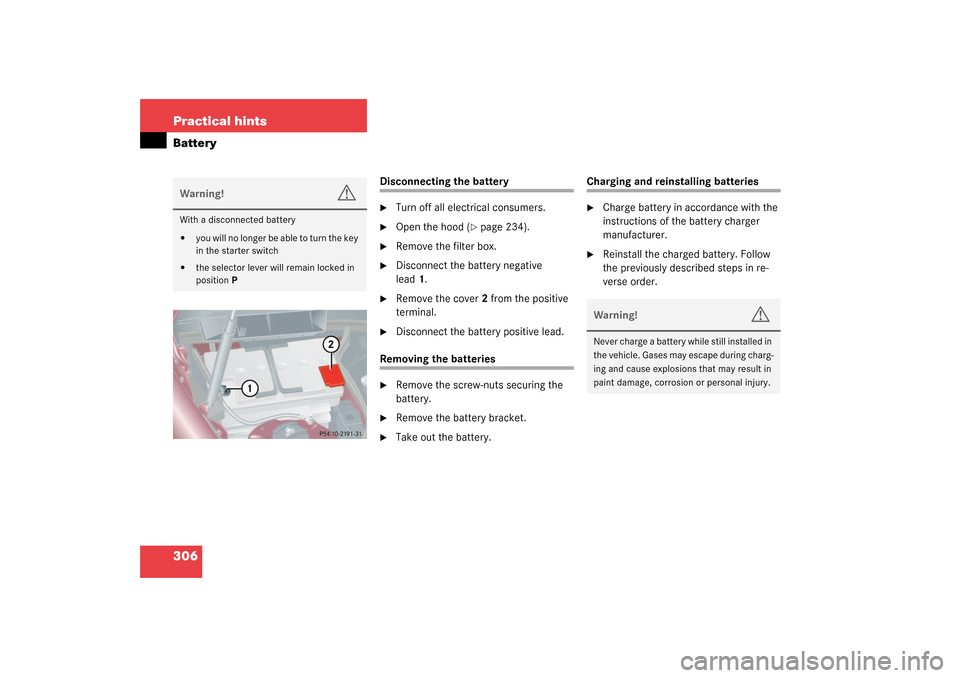
306 Practical hintsBattery
Disconnecting the battery�
Turn off all electrical consumers.
�
Open the hood (
�page 234).
�
Remove the filter box.
�
Disconnect the battery negative
lead1.
�
Remove the cover2 from the positive
terminal.
�
Disconnect the battery positive lead.
Removing the batteries�
Remove the screw-nuts securing the
battery.
�
Remove the battery bracket.
�
Take out the battery.
Charging and reinstalling batteries�
Charge battery in accordance with the
instructions of the battery charger
manufacturer.
�
Reinstall the charged battery. Follow
the previously described steps in re-
verse order.
Warning!
G
With a disconnected battery�
y o u w i l l n o l o n g e r b e a b l e t o t u r n t h e k e y
in the starter switch
�
the selector lever will remain locked in
positionP
Warning!
G
Never charge a battery while still installed in
the vehicle. Gases may escape during charg-
ing and cause explosions that may result in
paint damage, corrosion or personal injury.
S203 MY03_A.book Page 306 Tuesday, January 28, 2003 2:22 PM
Page 301 of 370
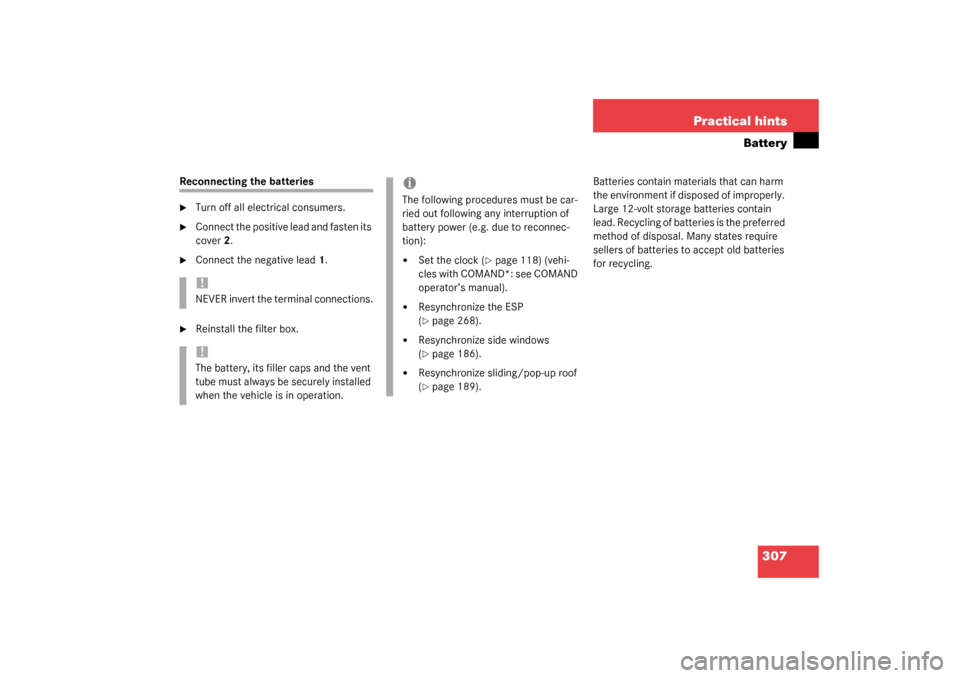
307 Practical hints
Battery
Reconnecting the batteries�
Turn off all electrical consumers.
�
Connect the positive lead and fasten its
cover2.
�
Connect the negative lead1.
�
Reinstall the filter box.Batteries contain materials that can harm
the environment if disposed of improperly.
Large 12-volt storage batteries contain
lead. Recycling of batteries is the preferred
method of disposal. Many states require
sellers of batteries to accept old batteries
for recycling.!NEVER invert the terminal connections.!The battery, its filler caps and the vent
tube must always be securely installed
when the vehicle is in operation.
iThe following procedures must be car-
ried out following any interruption of
battery power (e.g. due to reconnec-
tion):�
Set the clock (
�page 118) (vehi-
cles with COMAND*: see COMAND
operator’s manual).
�
Resynchronize the ESP
(�page 268).
�
Resynchronize side windows
(�page 186).
�
Resynchronize sliding/pop-up roof
(�page 189).
S203 MY03_A.book Page 307 Tuesday, January 28, 2003 2:22 PM
Page 302 of 370
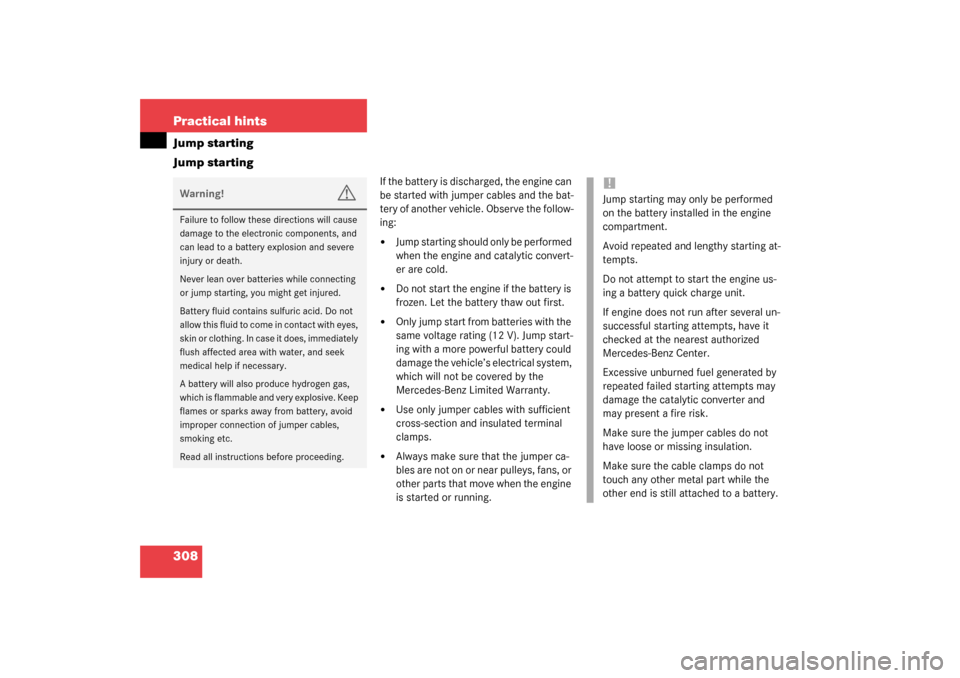
308 Practical hintsJump starting
Jump starting
If the battery is discharged, the engine can
be started with jumper cables and the bat-
tery of another vehicle. Observe the follow-
ing:�
Jump starting should only be performed
when the engine and catalytic convert-
er are cold.
�
Do not start the engine if the battery is
frozen. Let the battery thaw out first.
�
Only jump start from batteries with the
same voltage rating (12 V). Jump start-
ing with a more powerful battery could
damage the vehicle’s electrical system,
which will not be covered by the
Mercedes-Benz Limited Warranty.
�
Use only jumper cables with sufficient
cross-section and insulated terminal
clamps.
�
Always make sure that the jumper ca-
bles are not on or near pulleys, fans, or
other parts that move when the engine
is started or running.
Warning!
G
Failure to follow these directions will cause
damage to the electronic components, and
can lead to a battery explosion and severe
injury or death.
Never lean over batteries while connecting
or jump starting, you might get injured.
Battery fluid contains sulfuric acid. Do not
allow this fluid to come in contact with eyes,
skin or clothing. In case it does, immediately
flush affected area with water, and seek
medical help if necessary.
A battery will also produce hydrogen gas,
which is flammable and very explosive. Keep
flames or sparks away from battery, avoid
improper connection of jumper cables,
smoking etc.
Read all instructions before proceeding.
!Jump starting may only be performed
on the battery installed in the engine
compartment.
Avoid repeated and lengthy starting at-
tempts.
Do not attempt to start the engine us-
ing a battery quick charge unit.
If engine does not run after several un-
successful starting attempts, have it
checked at the nearest authorized
Mercedes-Benz Center.
Excessive unburned fuel generated by
repeated failed starting attempts may
damage the catalytic converter and
may present a fire risk.
Make sure the jumper cables do not
have loose or missing insulation.
Make sure the cable clamps do not
touch any other metal part while the
other end is still attached to a battery.
S203 MY03_A.book Page 308 Tuesday, January 28, 2003 2:22 PM
Page 303 of 370
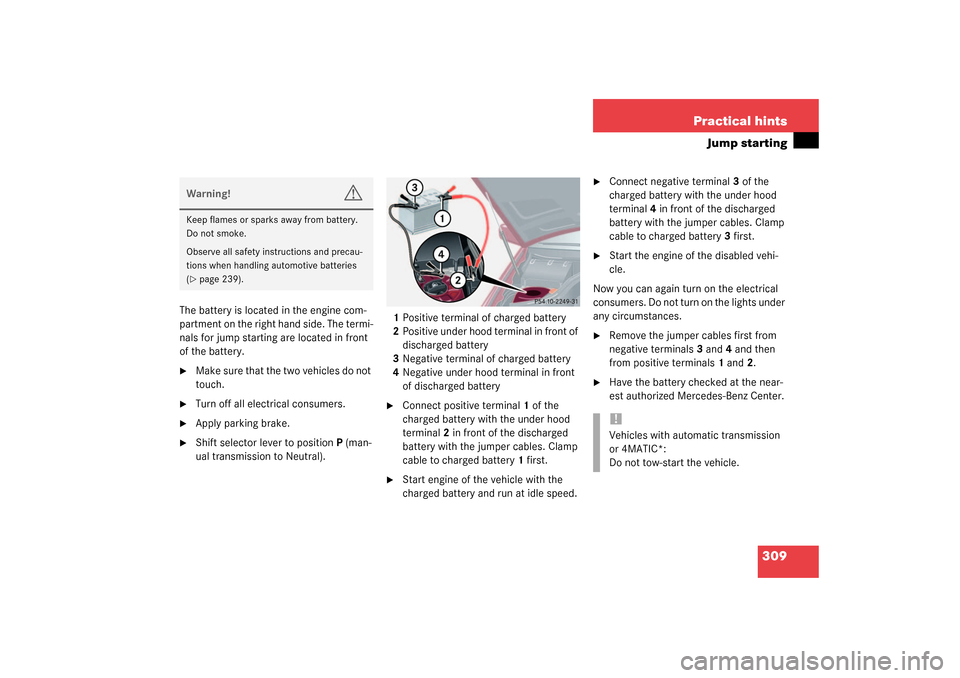
309 Practical hints
Jump starting
The battery is located in the engine com-
partment on the right hand side. The termi-
nals for jump starting are located in front
of the battery.�
Make sure that the two vehicles do not
touch.
�
Turn off all electrical consumers.
�
Apply parking brake.
�
Shift selector lever to positionP (man-
ual transmission to Neutral).1Positive terminal of charged battery
2Positive under hood terminal in front of
discharged battery
3Negative terminal of charged battery
4Negative under hood terminal in front
of discharged battery
�
Connect positive terminal1 of the
charged battery with the under hood
terminal2 in front of the discharged
battery with the jumper cables. Clamp
cable to charged battery1 first.
�
Start engine of the vehicle with the
charged battery and run at idle speed.
�
Connect negative terminal3 of the
charged battery with the under hood
terminal4 in front of the discharged
battery with the jumper cables. Clamp
cable to charged battery3 first.
�
Start the engine of the disabled vehi-
cle.
Now you can again turn on the electrical
consumers. Do not turn on the lights under
any circumstances.
�
Remove the jumper cables first from
negative terminals3 and4 and then
from positive terminals1 and2.
�
Have the battery checked at the near-
est authorized Mercedes-Benz Center.
Warning!
G
Keep flames or sparks away from battery.
Do not smoke.
Observe all safety instructions and precau-
tions when handling automotive batteries
(�page 239).
!Vehicles with automatic transmission
or 4MATIC*:
Do not tow-start the vehicle.
S203 MY03_A.book Page 309 Tuesday, January 28, 2003 2:22 PM
Page 306 of 370
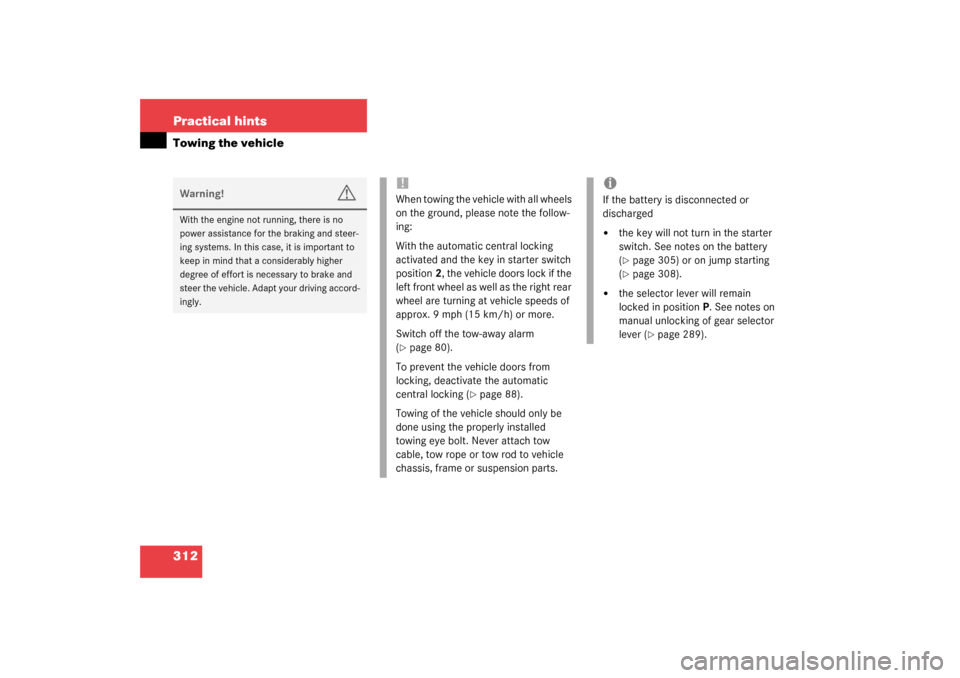
312 Practical hintsTowing the vehicleWarning!
G
With the engine not running, there is no
power assistance for the braking and steer-
ing systems. In this case, it is important to
keep in mind that a considerably higher
degree of effort is necessary to brake and
steer the vehicle. Adapt your driving accord-
ingly.
!When towing the vehicle with all wheels
on the ground, please note the follow-
ing:
With the automatic central locking
activated and the key in starter switch
position2, the vehicle doors lock if the
left front wheel as well as the right rear
wheel are turning at vehicle speeds of
approx. 9 mph (15 km/h) or more.
Switch off the tow-away alarm
(�page 80).
To prevent the vehicle doors from
locking, deactivate the automatic
central locking (
�page 88).
Towing of the vehicle should only be
done using the properly installed
towing eye bolt. Never attach tow
cable, tow rope or tow rod to vehicle
chassis, frame or suspension parts.
iIf the battery is disconnected or
discharged�
the key will not turn in the starter
switch. See notes on the battery
(�page 305) or on jump starting
(�page 308).
�
the selector lever will remain
locked in positionP. See notes on
manual unlocking of gear selector
lever (
�page 289).
S203 MY03_A.book Page 312 Tuesday, January 28, 2003 2:22 PM
Page 319 of 370
325 Technical data
Electrical system
Electrical system
Model
C 240
C 320
C 240 4MATIC
C 320 4MATIC
Generator (alternator)
14 V/120 A
14 V/120 A
Starter motor
12 V/1.7 kW
12 V/1.7 kW
Battery
12V/100 Ah
12V/100 Ah
Spark plugs
Bosch F 8 DPP332
NGK PFR 5 R-11
Bosch F 8 DPP332
NGK PFR 5 R-11
Electrode gap
0.039 in (1.0 mm)
0.039 in (1.0 mm)
Tightening torque
15 – 22 ft.lb (20 – 30 Nm)
15 – 22 ft.lb (20 – 30 Nm)
S203 MY03_A.book Page 325 Tuesday, January 28, 2003 2:22 PM
Page 337 of 370
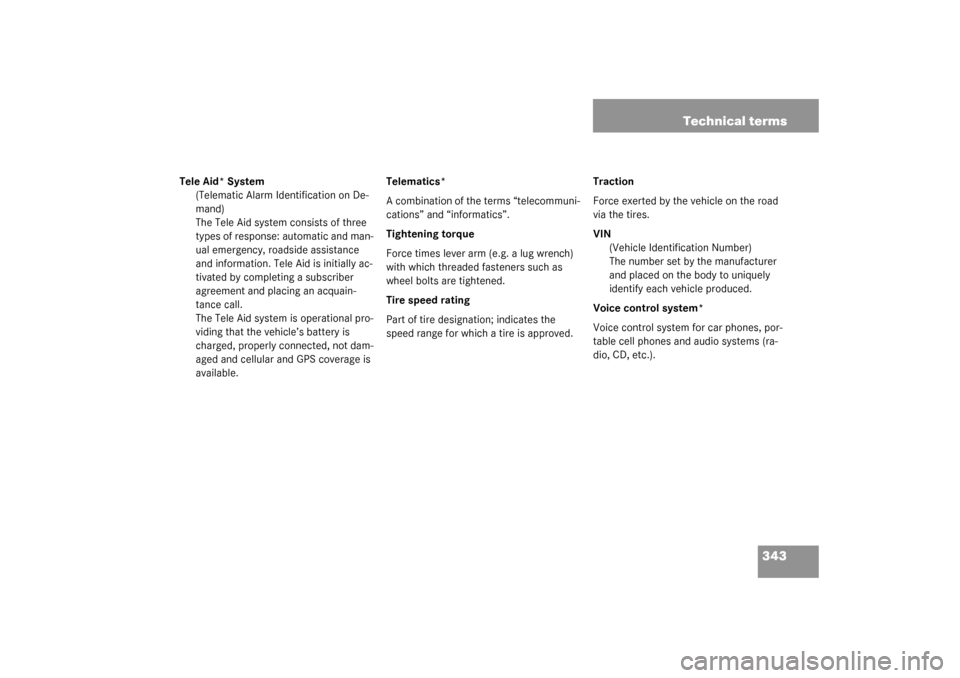
343 Technical terms
Tele Aid* System
(Telematic Alarm Identification on De-
mand)
The Tele Aid system consists of three
types of response: automatic and man-
ual emergency, roadside assistance
and information. Tele Aid is initially ac-
tivated by completing a subscriber
agreement and placing an acquain-
tance call.
The Tele Aid system is operational pro-
viding that the vehicle’s battery is
charged, properly connected, not dam-
aged and cellular and GPS coverage is
available.Telematics*
A combination of the terms “telecommuni-
cations” and “informatics”.
Tightening torque
Force times lever arm (e.g. a lug wrench)
with which threaded fasteners such as
wheel bolts are tightened.
Tire speed rating
Part of tire designation; indicates the
speed range for which a tire is approved.Traction
Force exerted by the vehicle on the road
via the tires.
VIN
(Vehicle Identification Number)
The number set by the manufacturer
and placed on the body to uniquely
identify each vehicle produced.
Voice control system*
Voice control system for car phones, por-
table cell phones and audio systems (ra-
dio, CD, etc.).
S203 MY03_A.book Page 343 Tuesday, January 28, 2003 2:22 PM
Page 341 of 370
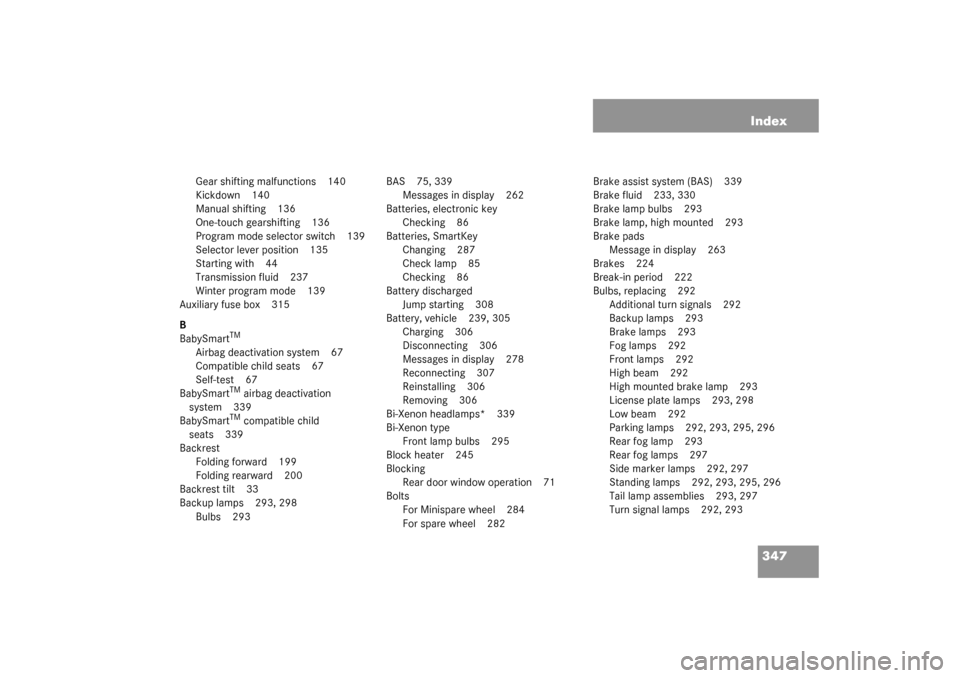
347 Index
Gear shifting malfunctions 140
Kickdown 140
Manual shifting 136
One-touch gearshifting 136
Program mode selector switch 139
Selector lever position 135
Starting with 44
Transmission fluid 237
Winter program mode 139
Auxiliary fuse box 315
B
BabySmart
TM
Airbag deactivation system 67
Compatible child seats 67
Self-test 67
BabySmart
TM airbag deactivation
system 339
BabySmartTM compatible child
seats 339
Backrest
Folding forward 199
Folding rearward 200
Backrest tilt 33
Backup lamps 293, 298
Bulbs 293BAS 75, 339
Messages in display 262
Batteries, electronic key
Checking 86
Batteries, SmartKey
Changing 287
Check lamp 85
Checking 86
Battery discharged
Jump starting 308
Battery, vehicle 239, 305
Charging 306
Disconnecting 306
Messages in display 278
Reconnecting 307
Reinstalling 306
Removing 306
Bi-Xenon headlamps* 339
Bi-Xenon type
Front lamp bulbs 295
Block heater 245
Blocking
Rear door window operation 71
Bolts
For Minispare wheel 284
For spare wheel 282Brake assist system (BAS) 339
Brake fluid 233, 330
Brake lamp bulbs 293
Brake lamp, high mounted 293
Brake pads
Message in display 263
Brakes 224
Break-in period 222
Bulbs, replacing 292
Additional turn signals 292
Backup lamps 293
Brake lamps 293
Fog lamps 292
Front lamps 292
High beam 292
High mounted brake lamp 293
License plate lamps 293, 298
Low beam 292
Parking lamps 292, 293, 295, 296
Rear fog lamp 293
Rear fog lamps 297
Side marker lamps 292, 297
Standing lamps 292, 293, 295, 296
Tail lamp assemblies 293, 297
Turn signal lamps 292, 293
S203 MY03_A.book Page 347 Tuesday, January 28, 2003 2:22 PM